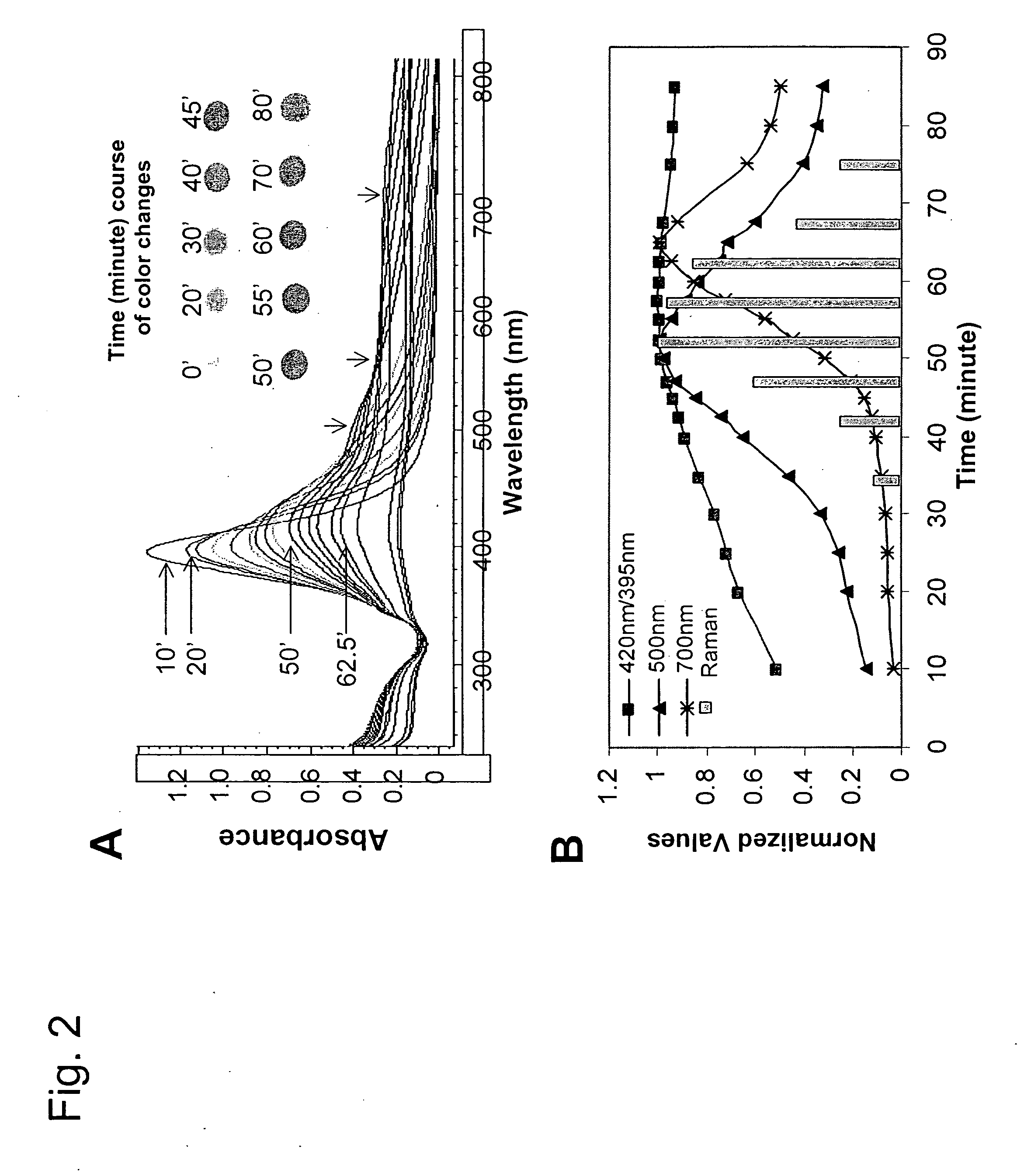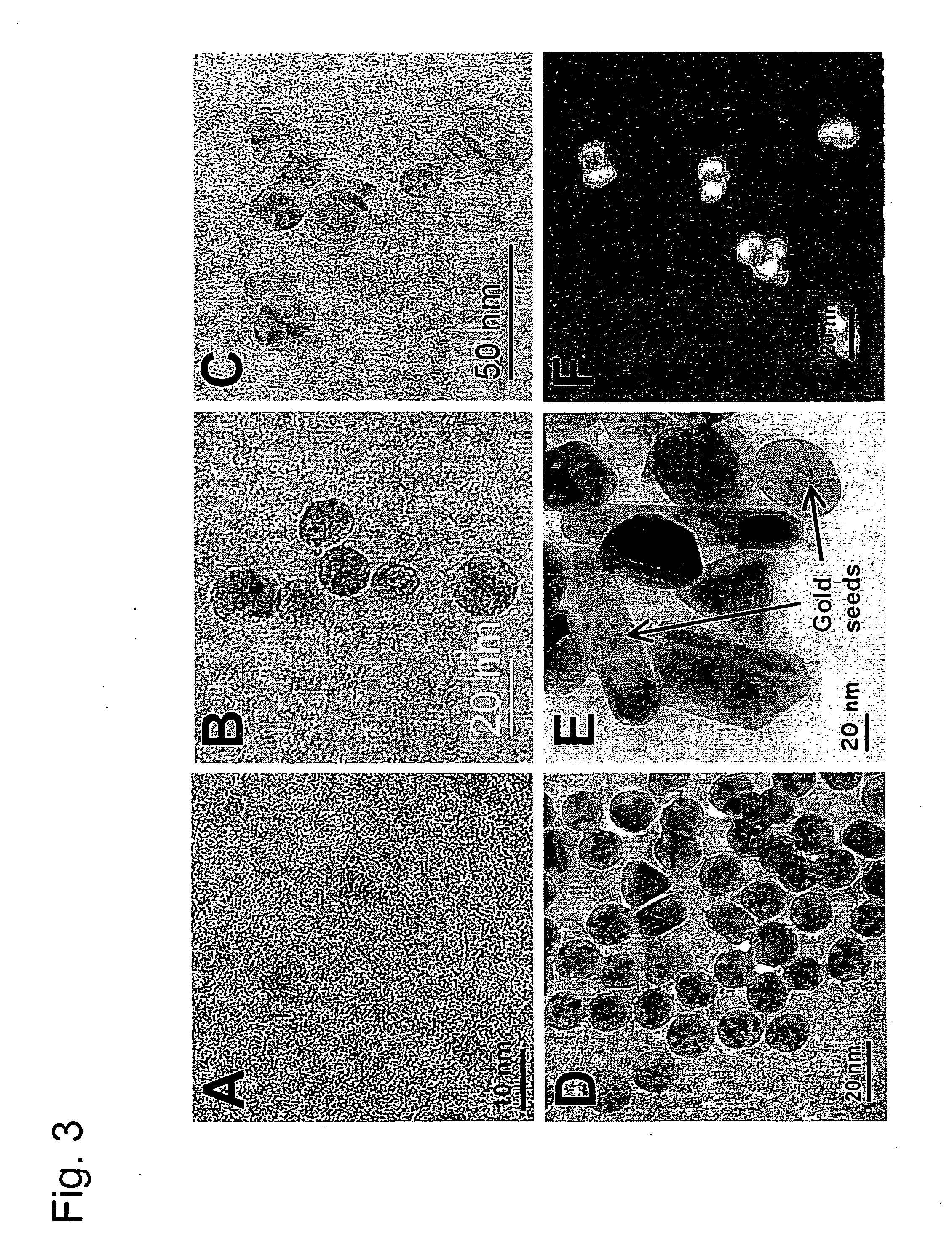Composite organic-inorganic nanoparticles and methods for use thereof
a technology of organic-inorganic nanoparticles and nanoparticles, which is applied in the field of nanoparticles, can solve the problems that none of the foregoing techniques is capable of quantitative measurement, and the use of sers has not been widespread
- Summary
- Abstract
- Description
- Claims
- Application Information
AI Technical Summary
Benefits of technology
Problems solved by technology
Method used
Image
Examples
example 1
Synthesis of Composite Organic-Inorganic Nanoparticles (COIN)
[0104] This example illustrates typical syntheses of the nanoparticles described herein.
[0105] Reflux method: To prepare COIN particles with silver seeds, typically, 50 mL silver seed suspension (equivalent to 2.0 mM Ag+) was heated to boiling in a reflux system before introducing Raman labels. Silver nitrate stock solution (0.500 M) was then added dropwise or in small aliquots (50-100 μL) to induce the growth and aggregation of silver seed particles. Up to a total of 2.5 mM silver nitrate could be added. The solution was kept boiling until the suspension became very turbid with a dark brown color. At this point, the temperature was lowered quickly by transferring the colloid solution into a glass bottle and then stored it at room temperature. The optimum heating time depended on the nature of Raman labels and amounts of silver nitrate addition. It was found helpful to verify that particles had reached a desired size ran...
example 2
Coin Raman Signals are Intrinsic
[0116] To further validate the COIN concept, Raman activity of standard SERS reactions was compared with Raman activities of COIN. As an example of a standard SERS reaction, a typical Raman spectrum was obtained when 4 μM aza-adenine was mixed with a silver colloid solution and a monovalent salt (FIG. 4A). When the salt was omitted from the reaction, Raman signals were not detected. To the contrary, a strong Raman signal was detected from a COIN sample with no salt added; but the Raman signal was greatly reduced when salt was included (FIG. 4B). The salt-independence of COIN signals suggested that, unlike standard SERS, salt-induced particle aggregation was not required for COIN to produce a Raman signal. Compared to the Raman spectrum of the standard SERS reaction, the peaks at 1100 cm−1 and 1570 cm−1 disappeared almost completely from the Raman spectrum of COIN. Similar phenomena were observed for other Raman labels that were tested (FIG. 8). The d...
example 3
A Wide Range of Raman Labels Can Be Incorporated into COIN
[0119] The above experimental results also suggest strongly that the Raman label molecules associated with the COIN particles interacted with silver metal in a way that was different from simple adsorption as in SERS. Since no covalent attachment was used, the label molecules were likely embedded or trapped in the metal lattices. This could occur during COIN synthesis because Raman labels were contacted with metal nanoparticles when the nanoparticles were undergoing enlargement and clustering. Small metal particles were chosen as seeds to provide a large surface area for initial Raman label absorption, and relatively high concentrations of Raman labels wee used to induce particle aggregation by reducing surface zeta potentials of the seed particles (FIG. 9). It was found that both Raman labels and an elevated temperature (i.e., boiling) were required for rapid silver atom rearrangement as indicated by the increased sizes of ...
PUM
| Property | Measurement | Unit |
|---|---|---|
| molecular weight | aaaaa | aaaaa |
| diameter | aaaaa | aaaaa |
| size | aaaaa | aaaaa |
Abstract
Description
Claims
Application Information
 Login to View More
Login to View More - R&D
- Intellectual Property
- Life Sciences
- Materials
- Tech Scout
- Unparalleled Data Quality
- Higher Quality Content
- 60% Fewer Hallucinations
Browse by: Latest US Patents, China's latest patents, Technical Efficacy Thesaurus, Application Domain, Technology Topic, Popular Technical Reports.
© 2025 PatSnap. All rights reserved.Legal|Privacy policy|Modern Slavery Act Transparency Statement|Sitemap|About US| Contact US: help@patsnap.com



